Sliver Of Saturn By NASA’s Marshall Space Flight Center

Sliver of Saturn by NASA’s Marshall Space Flight Center
More Posts from Starry-shores and Others
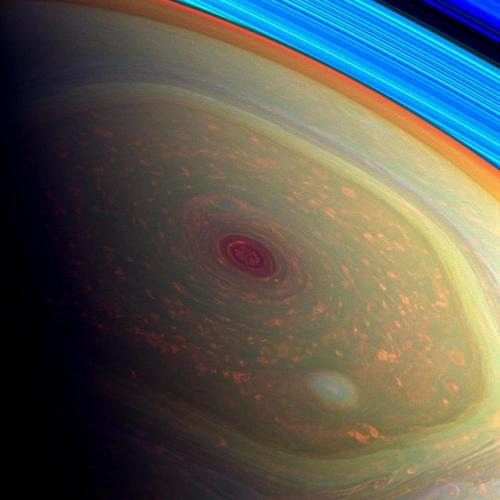
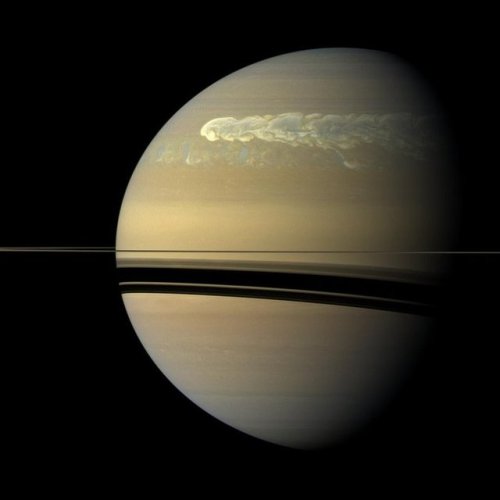
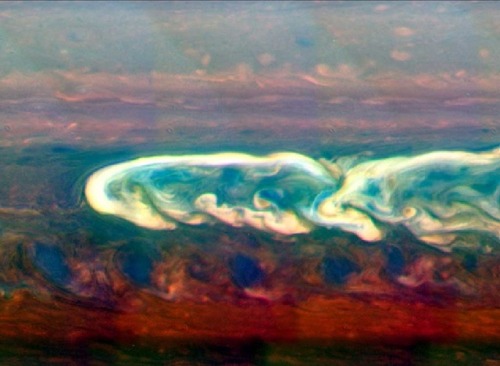



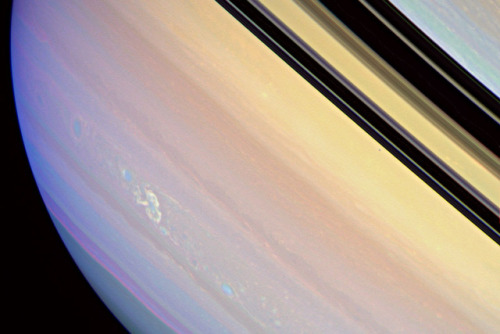

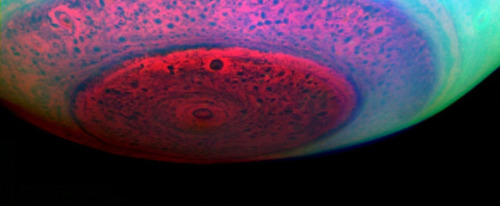
Saturn’s atmosphere exhibits a banded pattern similar to Jupiter’s, but Saturn’s bands are much fainter and are much wider near the equator. The nomenclature used to describe these bands is the same as on Jupiter. Saturn’s finer cloud patterns were not observed until the flybys of the Voyager spacecraft during the 1980s. Since then, Earth-based telescopy has improved to the point where regular observations can be made. The composition of the clouds varies with depth and increasing pressure.
The winds on Saturn are the second fastest among the Solar System’s planets, after Neptune’s. Voyager data indicate peak easterly winds of 500 m/s (1,800 km/h).
Thermography has shown that Saturn’s south pole has a warm polar vortex, the only known example of such a phenomenon in the Solar System. Whereas temperatures on Saturn are normally −185 °C, temperatures on the vortex often reach as high as −122 °C, suspected to be the warmest spot on Saturn.
Credit: NASA/JPL-Caltech/Space Science Institute and Kevin M. Gill


In Roman mythology, the god Jupiter drew a veil of clouds around himself to hide his mischief. It was only Jupiter’s wife, the goddess Juno, who could peer through the clouds and reveal Jupiter’s true nature. Our @NASAJuno spacecraft is looking beneath the clouds of the massive gas giant, not seeking signs of misbehavior, but helping us to understand the planet’s structure and history… Now, @NASAJuno just published its first findings on the amount of water in the gas giant’s atmosphere. The Juno results estimate that at the equator, water makes up about 0.25% of the molecules in Jupiter’s atmosphere — almost three times that of the Sun. An accurate total estimate of this water is critical to solving the mystery of how our solar system formed.
The JunoCam imager aboard Juno captured this image of Jupiter’s southern equatorial region on Sept. 1, 2017. The bottom image is oriented so Jupiter’s poles (not visible) run left-to-right of frame.
Image credit: NASA/JPL-Caltech/SwRI/MSSS/Kevin M. Gill

Great Basin National Park in Nevada is one of the darkest spots in the United States. What better time to appreciate this park’s clear night sky, then on International Day of Clean Air? Good air quality coupled with a lack of light pollution give visitors majestic starry views of Wheeler Peak. On clear, moonless nights at Great Basin, thousands of stars, numerous planets, star clusters, meteors, man-made satellites, the Andromeda Galaxy, and the Milky Way can be seen with the naked eye. The area boasts some of the darkest night skies left in the country. Low humidity, good air quality, and minimal light pollution, combined with high elevation, create a unique window to the universe. Photo by John Vermette (sharetheexperience.org). Photo description: A bright Milky Way and night sky filled with stars light up the mountains below.
Ultra-Close Orbits of Saturn = Ultra-Cool Science
On Sept. 15, 2017, our Cassini spacecraft ended its epic exploration of Saturn with a planned dive into the planet’s atmosphere–sending back new science to the very last second. The spacecraft is gone, but the science continues!

New research emerging from the final orbits represents a huge leap forward in our understanding of the Saturn system – especially the mysterious, never-before-explored region between the planet and its rings. Some preconceived ideas are turning out to be wrong while new questions are being raised. How did they form? What holds them in place? What are they made of?

Six teams of researchers are publishing their work Oct. 5 in the journal Science, based on findings from Cassini’s Grand Finale. That’s when, as the spacecraft was running out of fuel, the mission team steered Cassini spectacularly close to Saturn in 22 orbits before deliberately vaporizing it in a final plunge into the atmosphere in September 2017.

Knowing Cassini’s days were numbered, its mission team went for gold. The spacecraft flew where it was never designed to fly. For the first time, it probed Saturn’s magnetized environment, flew through icy, rocky ring particles and sniffed the atmosphere in the 1,200-mile-wide (2,000-kilometer-wide) gap between the rings and the cloud tops. Not only did the engineering push the spacecraft to its limits, the new findings illustrate how powerful and agile the instruments were.
Many more Grand Finale science results are to come, but today’s highlights include:
Complex organic compounds embedded in water nanograins rain down from Saturn’s rings into its upper atmosphere. Scientists saw water and silicates, but they were surprised to see also methane, ammonia, carbon monoxide, nitrogen and carbon dioxide. The composition of organics is different from that found on moon Enceladus – and also different from those on moon Titan, meaning there are at least three distinct reservoirs of organic molecules in the Saturn system.

For the first time, Cassini saw up close how rings interact with the planet and observed inner-ring particles and gases falling directly into the atmosphere. Some particles take on electric charges and spiral along magnetic-field lines, falling into Saturn at higher latitudes – a phenomenon known as “ring rain.” But scientists were surprised to see that others are dragged quickly into Saturn at the equator. And it’s all falling out of the rings faster than scientists thought – as much as 10,000 kg of material per second.

Scientists were surprised to see what the material looks like in the gap between the rings and Saturn’s atmosphere. They knew that the particles throughout the rings ranged from large to small. They thought material in the gap would look the same. But the sampling showed mostly tiny, nanograin- and micron-sized particles, like smoke, telling us that some yet-unknown process is grinding up particles. What could it be? Future research into the final bits of data sent by Cassini may hold the answer.

Saturn and its rings are even more interconnected than scientists thought. Cassini revealed a previously unknown electric current system that connects the rings to the top of Saturn’s atmosphere.

Scientists discovered a new radiation belt around Saturn, close to the planet and composed of energetic particles. They found that while the belt actually intersects with the innermost ring, the ring is so tenuous that it doesn’t block the belt from forming.

Unlike every other planet with a magnetic field in our Solar System, Saturn’s magnetic field is almost completely aligned with its spin axis. Think of the planet and the magnetic field as completely separate things that are both spinning. Both have the same center point, but they each have their own axis about which they spin. But for Saturn the two axes are essentially the same – no other planet does that, and we did not think it was even possible for this to happen. This new data shows a magnetic-field tilt of less than 0.0095 degrees. (Earth’s magnetic field is tilted 11 degrees from its spin axis.) According to everything scientists know about how planetary magnetic fields are generated, Saturn should not have one. It’s a mystery physicists will be working to solve.

Cassini flew above Saturn’s magnetic poles, directly sampling regions where radio emissions are generated. The findings more than doubled the number of reported crossings of radio sources from the planet, one of the few non-terrestrial locations where scientists have been able to study a mechanism believed to operate throughout the universe. How are these signals generated? That’s still a mystery researchers are looking to uncover.
For the Cassini mission, the science rolling out from Grand Finale orbits confirms that the calculated risk of diving into the gap – skimming the upper atmosphere and skirting the edge of the inner rings – was worthwhile.

Almost everything going on in that region turned out to be a surprise, which was the importance of going there, to explore a place we’d never been before. And the expedition really paid off!
Analysis of Cassini data from the spacecraft’s instruments will be ongoing for years to come, helping to paint a clearer picture of Saturn.
To read the papers published in Science, visit: URL to papers
To learn more about the ground-breaking Cassini mission and its 13 years at Saturn, visit: https://www.nasa.gov/mission_pages/cassini/main/index.html
Make sure to follow us on Tumblr for your regular dose of space: http://nasa.tumblr.com.



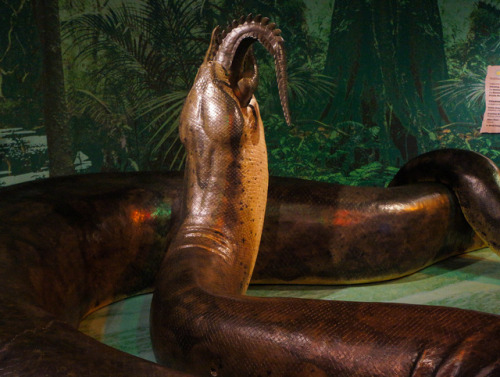
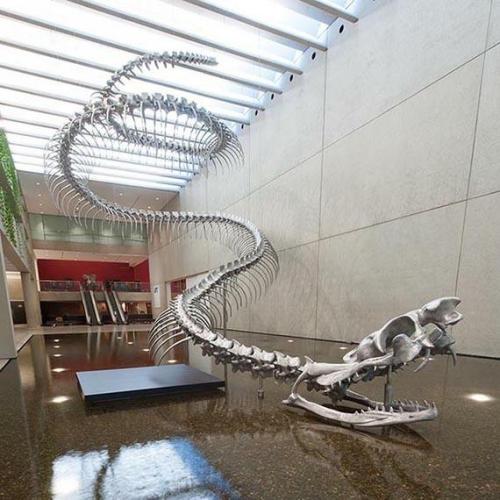

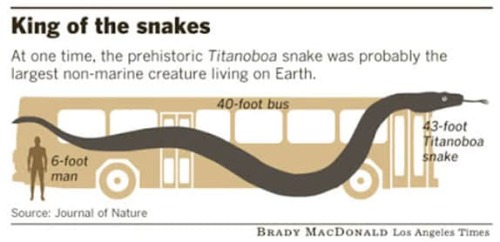
Titanoboa
Titanoboa is an extinct genus of snakes that is known to have lived in present-day La Guajira in northern Colombia. The giant snake lived during the Middle to Late Paleocene epoch, a 10-million-year period immediately following the Cretaceous-Paleogene extinction event.
The only known species is Titanoboa cerrejonensis, the largest snake ever discovered. By comparing the sizes and shapes of its fossilized vertebrae to those of extant snakes, researchers estimated that the largest individuals of T. cerrejonensis found had a total length around 42 feet and weighed about 2,500 pounds.
While initially thought to have been an apex predator of the Paleocene ecosystem in which it lived, evidence has pointed to the genus being predominantly piscivorous. Titanoboa’s massive size would have made it difficult to move on land, so the giant snake would probably have spent most of its life in the water, hunting for fish and other aquatic prey.
Hiking to the largest Ammonite in the world!
Video description:
Titanites lived during the Late Jurassic Period and had a shell diameter of around 137 centimetres! surprisingly it wasn’t the largest ammonoid, as some species such as Parapuzosia could get over twice as large!
There were also some plant fossils around the area of this site!
yeswe_travel
Look how littel I am, next to this massive mountain..
Can you see the beauty around me ✨ .
DE)

Daphnis and the Rings of Saturn : What’s happening to the rings of Saturn? A little moon making big waves. The moon is 8-kilometer Daphnis and it is making waves in the Keeler Gap of Saturn’s rings using just its gravity – as it bobs up and down, in and out. The featured image is a colored and more detailed version of a previously released images taken in 2017 by the robotic Cassini spacecraft during one of its Grand Finale orbits. Daphnis can be seen on the far right, sporting ridges likely accumulated from ring particles. Daphnis was discovered in Cassini images in 2005 and raised mounds of ring particles so high in 2009 – during Saturn’s equinox when the ring plane pointed directly at the Sun – that they cast notable shadows. via NASA
gocmnh
It’s Dunkleosteus, the Devonian Destroyer! This specimen was discovered right here in Cleveland.
-
 grimsleaper reblogged this · 3 years ago
grimsleaper reblogged this · 3 years ago -
 illicitlimerence reblogged this · 3 years ago
illicitlimerence reblogged this · 3 years ago -
 garnethoney reblogged this · 3 years ago
garnethoney reblogged this · 3 years ago -
 instaaestetic reblogged this · 3 years ago
instaaestetic reblogged this · 3 years ago -
 megarambler reblogged this · 3 years ago
megarambler reblogged this · 3 years ago -
 mm-96 reblogged this · 4 years ago
mm-96 reblogged this · 4 years ago -
 spelllweaver reblogged this · 4 years ago
spelllweaver reblogged this · 4 years ago -
 anderwhohn-moved reblogged this · 4 years ago
anderwhohn-moved reblogged this · 4 years ago -
 jcgraas liked this · 4 years ago
jcgraas liked this · 4 years ago -
 choooccoto reblogged this · 4 years ago
choooccoto reblogged this · 4 years ago -
 haus-of-commons liked this · 4 years ago
haus-of-commons liked this · 4 years ago -
 blackmoonhunter reblogged this · 4 years ago
blackmoonhunter reblogged this · 4 years ago -
 townesvanzandtfan53 liked this · 4 years ago
townesvanzandtfan53 liked this · 4 years ago -
 jank-horse reblogged this · 4 years ago
jank-horse reblogged this · 4 years ago -
 jank-horse liked this · 4 years ago
jank-horse liked this · 4 years ago -
 lateniteradio liked this · 4 years ago
lateniteradio liked this · 4 years ago -
 adhrpr liked this · 4 years ago
adhrpr liked this · 4 years ago -
 mavricngoose liked this · 4 years ago
mavricngoose liked this · 4 years ago -
 nelc reblogged this · 4 years ago
nelc reblogged this · 4 years ago -
 sweetwombatcandy liked this · 4 years ago
sweetwombatcandy liked this · 4 years ago -
 darealestmofo reblogged this · 4 years ago
darealestmofo reblogged this · 4 years ago -
 mhdragab reblogged this · 4 years ago
mhdragab reblogged this · 4 years ago -
 danielledreamsthedayaway reblogged this · 4 years ago
danielledreamsthedayaway reblogged this · 4 years ago -
 kunachris liked this · 4 years ago
kunachris liked this · 4 years ago -
 give-me-back-my-legions liked this · 4 years ago
give-me-back-my-legions liked this · 4 years ago -
 nelc liked this · 4 years ago
nelc liked this · 4 years ago -
 cybermax reblogged this · 4 years ago
cybermax reblogged this · 4 years ago -
 sprcomptdra-atocatl reblogged this · 4 years ago
sprcomptdra-atocatl reblogged this · 4 years ago -
 ave-el-sol reblogged this · 4 years ago
ave-el-sol reblogged this · 4 years ago -
 gothware reblogged this · 4 years ago
gothware reblogged this · 4 years ago -
 wuwuya liked this · 4 years ago
wuwuya liked this · 4 years ago -
 krisleethatsme reblogged this · 4 years ago
krisleethatsme reblogged this · 4 years ago -
 krisleethatsme liked this · 4 years ago
krisleethatsme liked this · 4 years ago -
 mopoki reblogged this · 4 years ago
mopoki reblogged this · 4 years ago -
 jfictitional liked this · 4 years ago
jfictitional liked this · 4 years ago -
 yhamh liked this · 4 years ago
yhamh liked this · 4 years ago -
 thund3rlord7 reblogged this · 4 years ago
thund3rlord7 reblogged this · 4 years ago -
 thund3rlord7 liked this · 4 years ago
thund3rlord7 liked this · 4 years ago -
 moonloverrrr reblogged this · 4 years ago
moonloverrrr reblogged this · 4 years ago

Amateur astronomer, owns a telescope. This is a side blog to satiate my science-y cravings! I haven't yet mustered the courage to put up my personal astro-stuff here. Main blog : @an-abyss-called-life
212 posts
